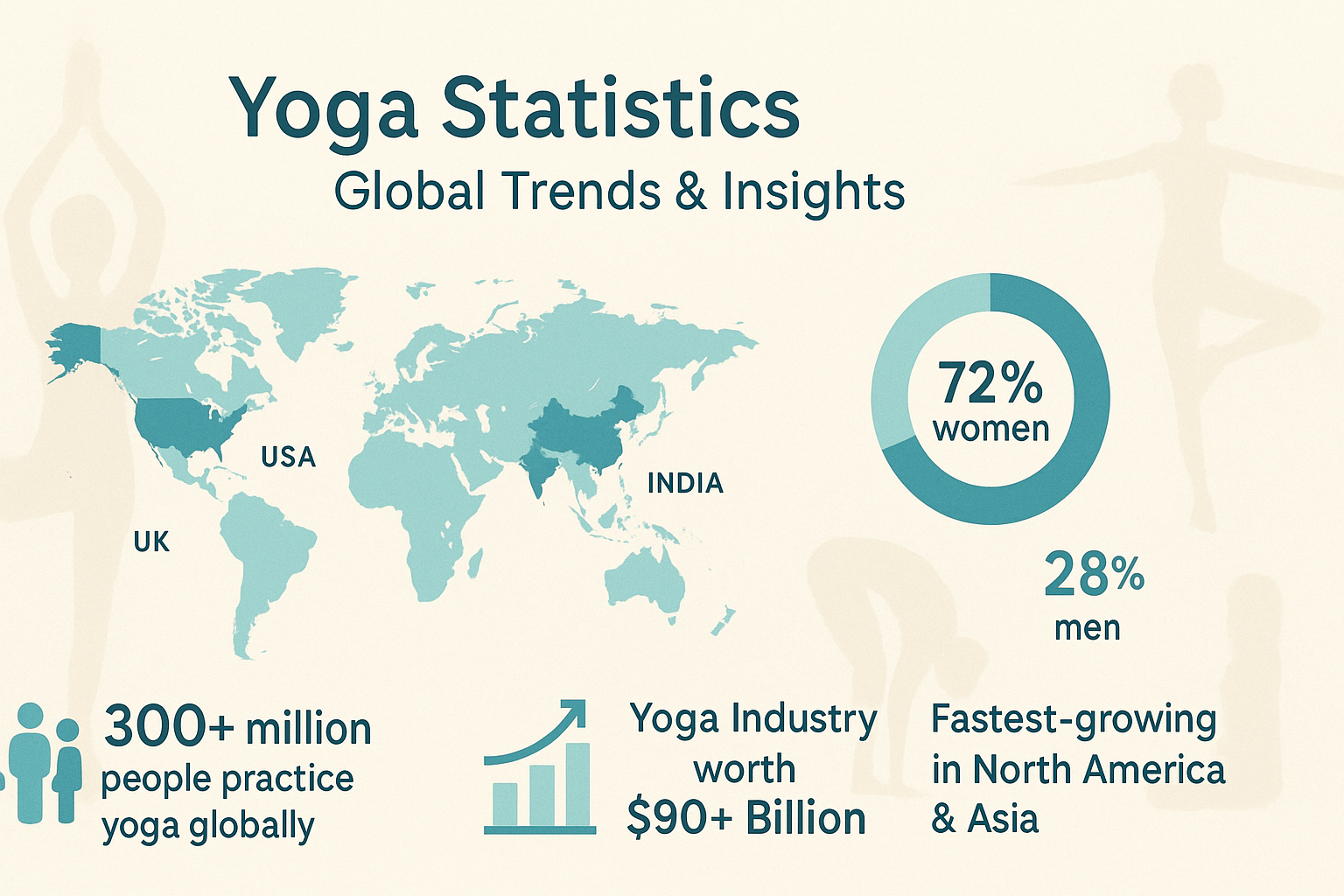Yoga has come a long way from its roots in ancient India. What started thousands of years ago as a spiritual and meditative practice is now a global wellness movement loved by millions.
Today, yoga isn’t just about stretching or meditation — it’s a way for people to manage stress, stay fit, and find balance in their busy, tech-filled lives.
This article looks at the latest yoga statistics around the world, how many people are practicing it, where it’s growing fastest, and what the future of yoga looks like as we move toward 2030.
The numbers come from trusted sources like Yoga Alliance, Statista, and the Global Wellness Institute.
Key Takeaways (Quick Facts)
- Over 300 million people practice yoga regularly worldwide as of 2025
- The global yoga industry is valued at $107-120 billion in 2025, projected to reach $200+ billion by 2030
- The yoga market is expanding at a compound annual growth rate (CAGR) of 9.4%
- United States, India, China, United Kingdom, and Germany lead in yoga participation
- Women comprise 72-80% of practitioners globally, though male participation is steadily increasing
- The largest practitioner group falls within the 30-49 age range, representing over 40% of yogis
- Americans spend approximately $16 billion annually on yoga classes, equipment, and accessories
- Over 120 million practitioners rely on virtual classes, with online yoga expected to surpass $30 billion by 2027
- Hybrid yoga models (in-person + online), corporate wellness programs, AI-assisted training, and yoga tourism
- 72% Yoga practitioners are female and 28% men
- Average spending is around $1,200–$1,500 per year on yoga gear, classes, and retreats
How Many People Practice Yoga Worldwide?
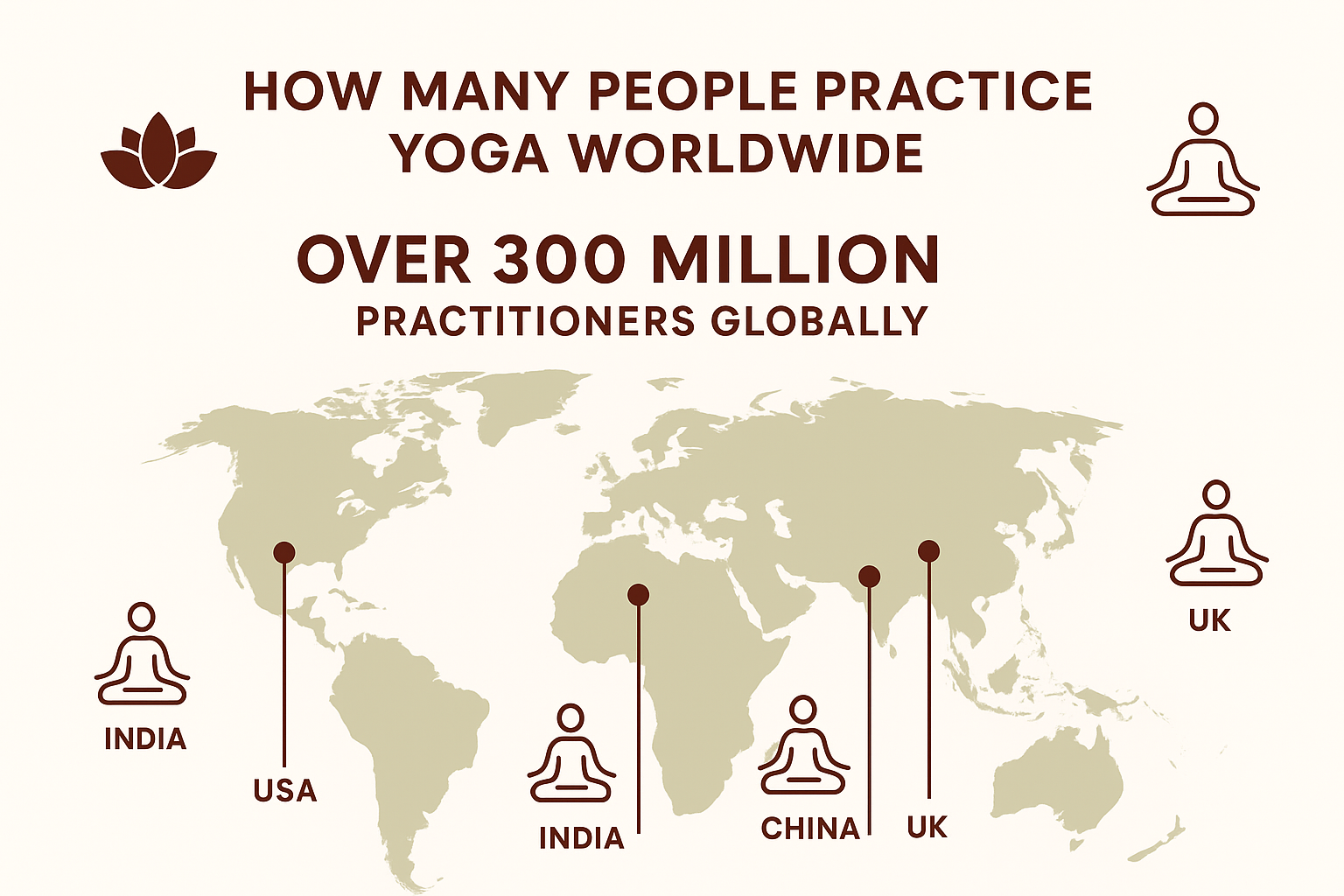
As of 2025, more than 300 million individuals practice yoga regularly worldwide. This represents a remarkable expansion from previous decades. Between 2010 and 2021, yoga’s popularity surged by 63.8%, demonstrating accelerating adoption rates that show no signs of slowing.
To put this in perspective, the global yoga community now rivals the population of the United States. This massive practitioner base spans every continent, age group, and socioeconomic background, reflecting yoga’s universal appeal and adaptability.
The number of yoga studios has also expanded dramatically, with currently 48,547 yoga and pilates studios operating in the United States alone. Additionally, more than 100,000 teachers are registered with Yoga Alliance, though the actual number of yoga instructors globally is significantly higher when including unregistered teachers and traditional practitioners.
Regional Distribution
The global yoga landscape features distinct regional characteristics and growth patterns:
Asia-Pacific: The Asia-Pacific region accounts for approximately 37.2% of the global yoga market revenue, making it the largest regional market. India, as yoga’s birthplace, maintains the highest percentage of practitioners relative to population, though China and Japan are experiencing rapid growth. Japan has witnessed a 413% increase in yoga practitioners over the last five years.
North America: North America represented 27.3% of the global yoga market in 2023, with the United States serving as a major driver of both practice and innovation. The region leads in premium yoga products, teacher training programs, and digital platform development.
Europe: European nations show steady growth with particular strength in Germany, the United Kingdom, and increasingly Italy. Italy is emerging as the fastest-growing regional market, while wellness tourism centered around yoga is expanding in Spain, Portugal, and Greece.
Latin America: Countries like Brazil and Mexico are experiencing increasing yoga adoption, particularly among younger demographics interested in fitness and mental health. Latin America is expected to account for about 10% of the global yoga market by 2025.
Australia & Oceania: Australia has a well-established yoga culture with high per-capita participation rates. The country currently has 3,314 yoga studios, representing significant market penetration for its population size.
Countries By Most Number Of Yoga Practitioners
While exact practitioner numbers by country remain challenging to verify due to varying survey methodologies, the following countries represent the largest yoga communities based on available data and market analysis:
| Rank | Country | Estimated Practitioners | % of Population | Market Characteristics |
| 1 | 🇮🇳 India | 50-70 million | 4-6% | Birthplace of yoga; traditional and modern styles coexist; rapidly growing wellness tourism; strong government support |
| 2 | 🇺🇸 United States | 36-42 million | 10-11% | Largest commercial market; high consumer spending; innovation hub; diverse style offerings |
| 3 | 🇨🇳 China | 30-40 million | 2-3% | Fast-growing market; increasing urban adoption; hybrid Eastern-Western approaches |
| 4 | 🇧🇷 Brazil | 5-8 million | 2-3% | Growing Latin American leader; young demographic base; fitness-oriented approach |
| 5 | 🇬🇧 United Kingdom | 4-5 million | 6-7% | Mature market; strong studio culture; wellness integration |
| 6 | 🇩🇪 Germany | 3-4 million | 4-5% | Health-focused approach; insurance coverage for yoga therapy |
| 7 | 🇨🇦 Canada | 3-4 million | 8-10% | High per-capita participation; similar trends to US market |
| 8 | 🇦🇺 Australia | 2-3 million | 8-11% | Very high per-capita rates; outdoor yoga culture; premium market |
| 9 | 🇯🇵 Japan | 2-3 million | 2-3% | Fastest regional growth rate; corporate wellness integration |
| 10 | 🇫🇷 France | 2-3 million | 3-4% | Growing European market; wellness tourism destination |
Demographics of Yoga Practitioners
Gender Distribution
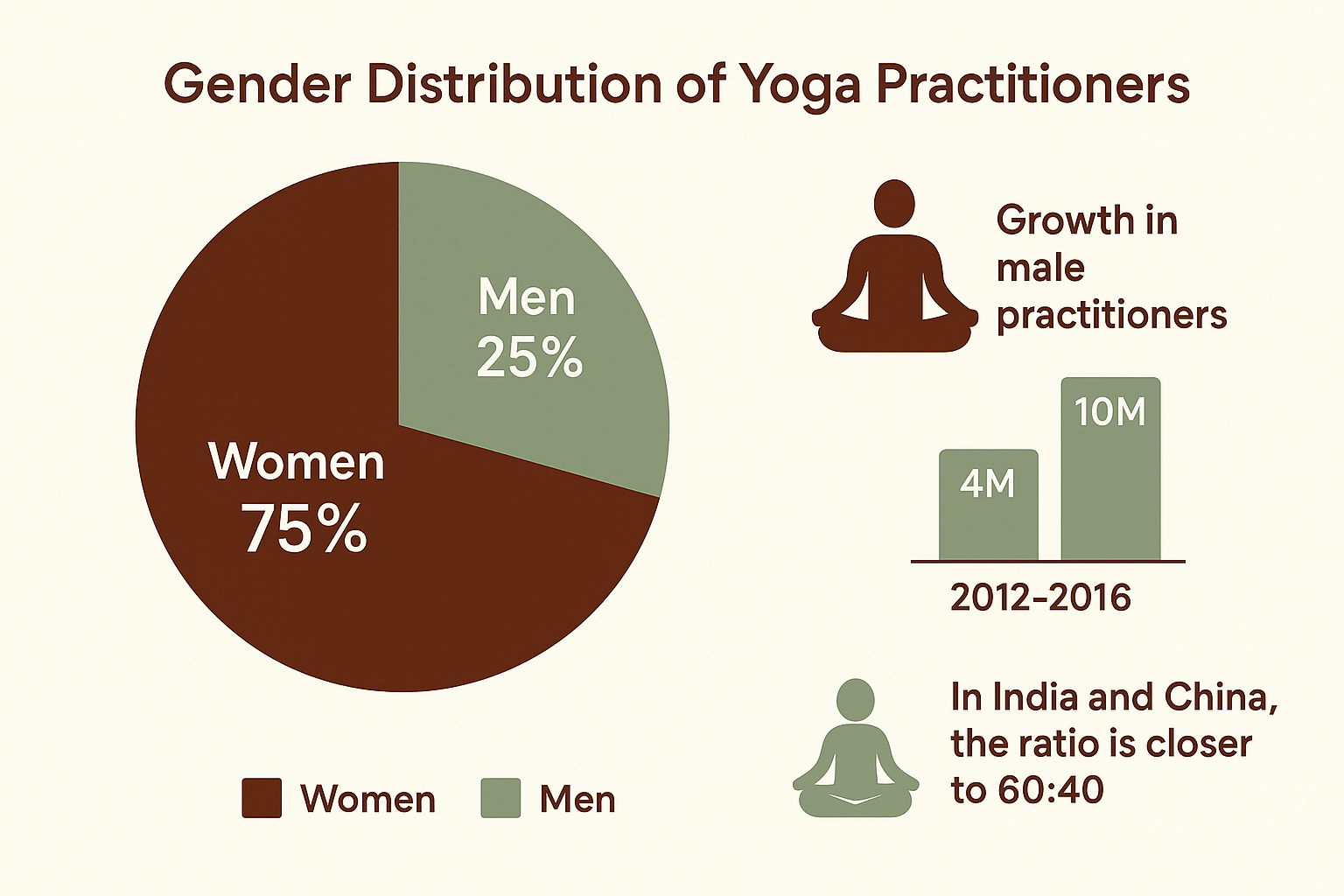
Women make up the majority of practitioners, representing 72-80% according to different surveys. This gender distribution reflects yoga’s Western popularization primarily through female adoption, particularly during the 1970s through early 2000s.
However, the landscape is evolving. Between 2012 and 2016, the number of men practicing yoga in the United States grew from 4 million to 10 million, marking a 150% increase. Male participation is steadily increasing, especially in countries like India and China, where the split is closer to 60:40.
Several factors are driving increased male participation:
- Growing awareness of yoga’s strength-building and athletic performance benefits
- Marketing campaigns specifically targeting men
- Male celebrity endorsements from athletes and actors
- More diverse class offerings including power yoga and athletic-focused styles
- Reduced stigma around men participating in wellness activities
Age Distribution
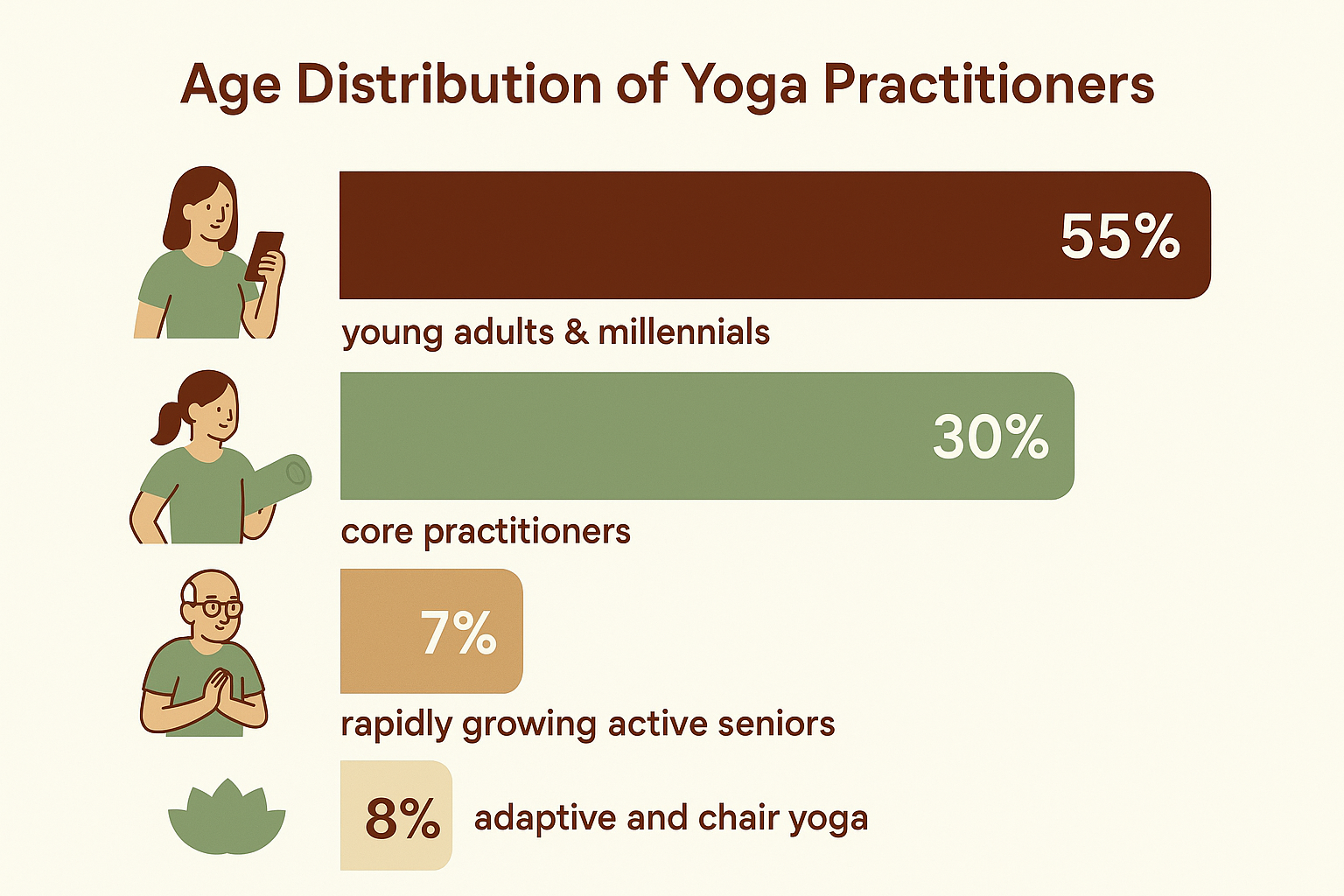
The largest group of yoga practitioners falls within the 30-49 age range, representing the core demographic. However, yoga’s reach extends across the entire age spectrum with notable trends:
Ages 18-29 (Young Adults & Millennials): Millennials and Gen Z practitioners make up about 55% of all yoga practitioners in 2025. This group is particularly drawn to digital offerings, social aspects of practice, and fitness-oriented styles. They drive trends in online classes, app-based subscriptions, and social media yoga content.
Ages 30-49 (Core Practitioners): This demographic represents the most consistent and dedicated practitioner base. They typically have higher disposable incomes, attend classes regularly, and invest in premium equipment and retreats.
Ages 50-64 (Active Seniors): The number of over-50s practicing yoga has tripled over the last four years. This group seeks yoga primarily for flexibility, joint health, stress reduction, and chronic pain management.
Ages 65+ (Older Adults): In 2022, 8.0% of adults age 65 and older practiced yoga. Adaptive yoga and chair yoga are helping older adults stay mobile and connected, making yoga increasingly accessible to aging populations.
Children & Teens: Schools are increasingly incorporating yoga, breathwork, and mindfulness into curricula. Statistics show that children are more likely to take part in yoga if one of their parents does, with 37% of yoga practitioners having children who also practice.
Location Demographics
Urban vs. Rural: Yoga participation remains highest in urban and suburban areas where studio access, class variety, and community support are most robust. However, online platforms are rapidly democratizing access to rural and remote areas.
Income Correlation: The percentage of adults who practiced yoga increased with increasing family income, from 10.4% among adults with family incomes less than 200% of the federal poverty level to 23.0% among adults with family incomes at 400% FPL or more.
Ethnic Diversity: In the U.S., 38% of practitioners now identify as people of color, reflecting growing inclusivity efforts. Asian adults (22.5%) were more likely to practice yoga than White (19.3%), other and multiple races (15.7%), Black (12.6%), and Hispanic (10.5%) adults.
How Many People Practice Yoga In The USA?
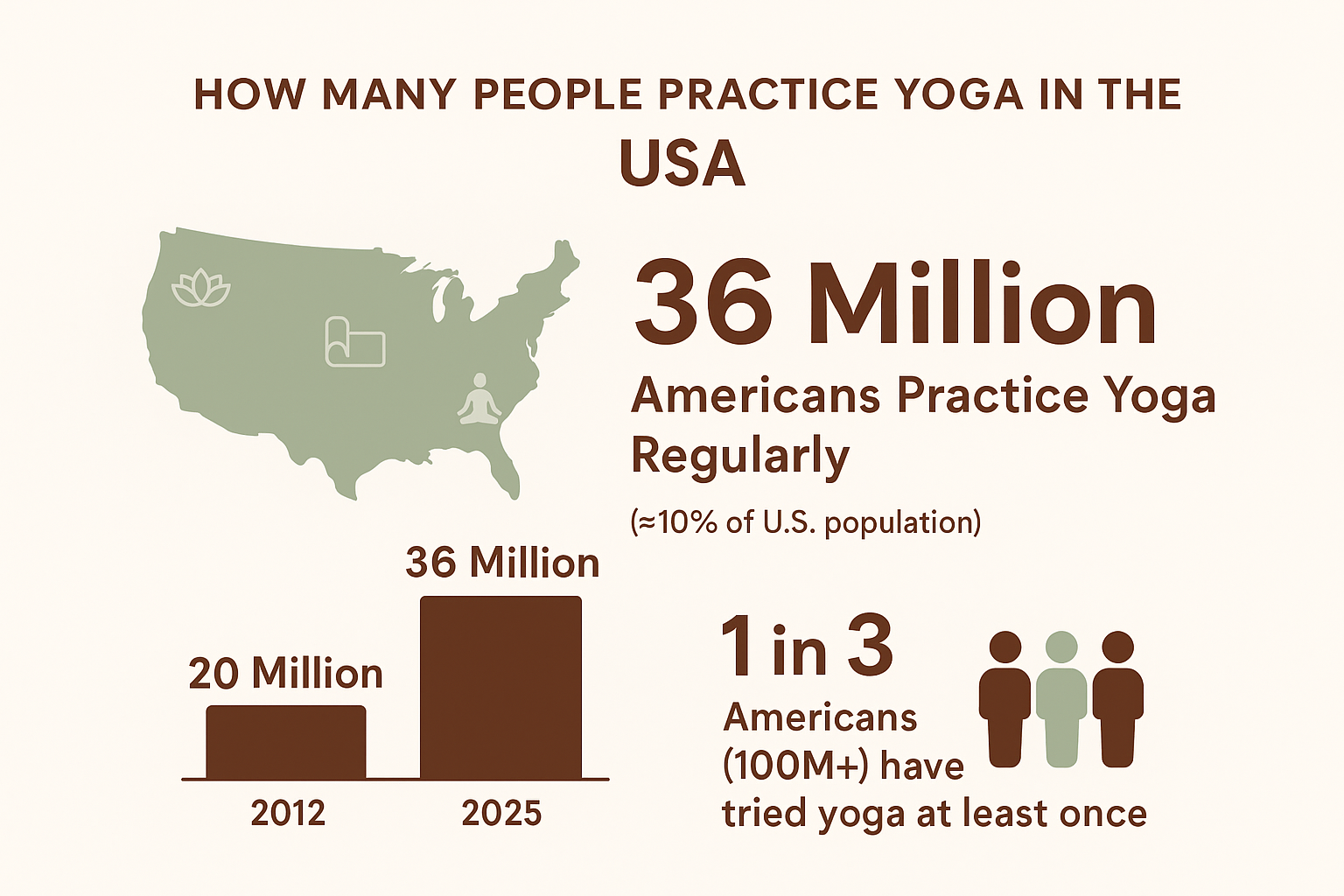
Approximately 36 million Americans practice yoga regularly, representing roughly 10% of the current US population. This figure marks substantial growth from previous years: that number is up significantly from 20 million in 2012.
Beyond regular practitioners, yoga’s reach extends much further. Approximately 1 in every 3 Americans has practiced yoga at least once in their lives, representing over 100 million people who have experienced yoga in some form.
Gender Breakdown (USA)
Women (23.3%) are more than twice as likely as men (10.3%) to practice yoga in the United States. This gender gap, while still significant, has been narrowing as yoga becomes increasingly recognized for athletic performance enhancement and stress management benefits that appeal to men.
Age Distribution (USA)
The percentage of adults who practiced yoga decreased with increasing age, from 21.3% of adults ages 18-44 to 8.0% of those age 65 and older. Young and middle-aged adults represent the most active segment, though participation among seniors is growing steadily.
Geographic Distribution
There are approximately 42,216 yoga centers currently in all the states of America, though this number includes combined yoga and pilates studios.
While comprehensive state-by-state practitioner data is limited, yoga participation and studio concentration reveal regional patterns:
| Rank | State | Key Characteristics | Major Hubs |
| 1 | California | Undisputed yoga capital of America; highest number of studios, practitioners, and yoga-related businesses; innovation leader | Los Angeles, San Francisco, San Diego |
| 2 | New York | Second largest market; diverse styles and prestigious training programs; strong metropolitan concentration | New York City, Brooklyn, Long Island |
| 3 | Florida | Large retirement population drives senior yoga participation; wellness tourism destination | Miami, Tampa, Orlando |
| 4 | Texas | Rapidly growing market in urban centers; strong millennial adoption | Austin, Dallas, Houston |
| 5 | Colorado | High per-capita participation rates; strong outdoor yoga culture; wellness lifestyle integration | Denver, Boulder, Aspen |
| 6 | Washington | Vibrant community with high participation rates; tech industry wellness culture | Seattle, Bellevue, Tacoma |
| 7 | Oregon | Highest per-capita participation cities; progressive wellness culture; eco-conscious practitioners | Portland, Eugene, Bend |
| 8 | Massachusetts | Established yoga communities; academic research centers; strong healthcare integration | Boston, Cambridge, Northampton |
| 9 | Illinois | Major Midwest yoga hub; diverse studio offerings; growing corporate wellness adoption | Chicago, Evanston, Oak Park |
| 10 | Arizona | Attracts yoga tourists; strong local communities; desert retreat culture | Phoenix, Scottsdale, Sedona |
Global vs. USA Comparison
The United States represents approximately 12% of global yoga practitioners while comprising only 4% of world population, indicating significantly higher per-capita participation rates compared to most countries. American practitioners also tend to spend considerably more on yoga-related products and services, making the US market disproportionately important to the global yoga economy.
Yoga Industry and Economic Impact
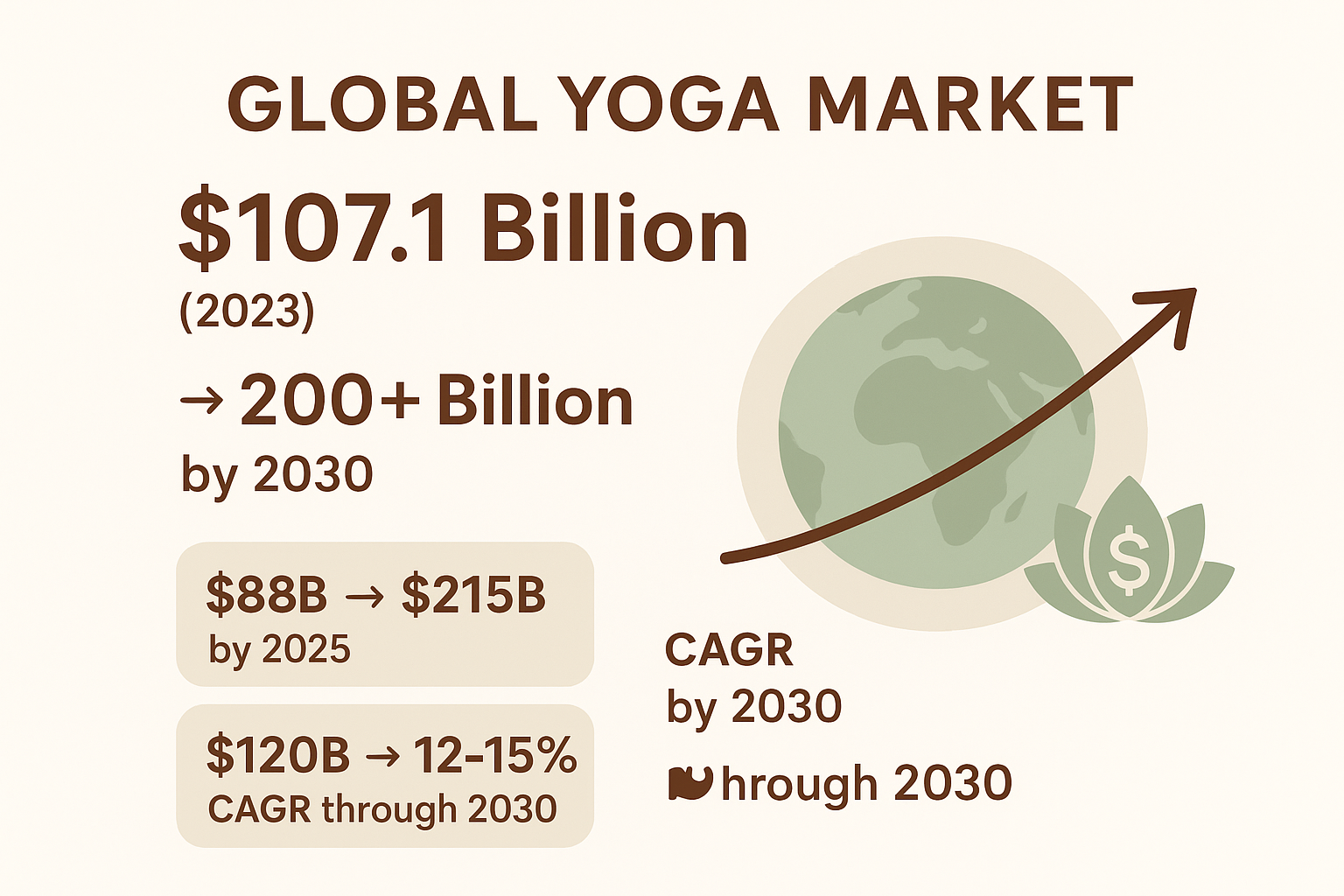
Market Size and Growth
The global yoga market size was estimated at USD 107.1 billion in 2023 and is expected to grow at a compound annual growth rate (CAGR) of 9.4% from 2024 to 2030. The market is expected to reach USD 200.35 billion by 2030.
Different market analyses show slightly varying valuations based on methodology:
- Some industry estimates value the global yoga industry at $88 billion, predicted to reach $215 billion by 2025
- Other analyses place the 2025 global yoga industry value at over $120 billion, projected to grow at 12-15% CAGR through 2030
These variations reflect different methodologies and market segment inclusions, but all analyses confirm explosive growth trajectories.
Revenue Streams
The yoga industry generates revenue through multiple channels:
Studio Operations: The American yoga studio market is worth $11.8bn, though experiencing flat growth as practitioners shift toward hybrid models combining in-person and online classes.
Online Platforms & Apps: The digital yoga market (online classes & apps) is expected to surpass $30 billion by 2027. More than 120 million yoga practitioners rely on virtual classes in 2025.
Yoga Apparel: The yoga clothing market size stands at USD 28.47 billion in 2025 and is projected to reach USD 42.43 billion by 2030, advancing at an 8.31% CAGR.
Equipment & Accessories: The yoga mat industry generates $8.9bn worldwide and continues to grow at 6.8% each year. The yoga accessories market is projected to grow from USD 18.9 billion in 2025 to USD 28.4 billion by 2030, exhibiting a CAGR of 8.4%.
Yoga Tourism & Retreats: The global yoga tourism market is valued at USD 72 billion in 2025 with a projected CAGR of 10% through 2032. The global wellness tourism industry is set to grow to $1.3 trillion by 2030, with yoga retreats being a major contributor.
Teacher Training Programs: Yoga teacher training represents a significant revenue stream, with programs ranging from $2,000 to $10,000+ for 200-hour certifications.
Employment Statistics
According to Yoga Alliance, there are now an estimated 300,000 yoga teachers worldwide. In the United States specifically, there are over 14,752 yoga teachers currently employed, though this number captures only formally employed instructors and excludes independent contractors.
Teacher Demographics:
- 85.5% of yoga teachers are female and 14.5% are male
- The average age of yoga teachers is approximately 37.5 years
- 71.3% of yoga instructors are White, followed by Hispanic or Latino (10.6%), and Black or African American (7.1%)
Earnings: Yoga instructors earn an average of $24.96 per hour, with the average professional earning between $31,000 and $100,000. Experienced yoga teachers can earn upwards of $80,000 annually, depending on location, specialization, and whether they own studios or work primarily as independent contractors.
55% of yoga teachers currently teach part-time, while 30% transition into full-time instructors after completing a 200-hour Yoga Teacher Training (YTT) course.
Consumer Spending
Each year, Americans spend around $16 billion on yoga classes, accessories, and equipment. This represents a substantial increase from $10 billion in 2012, demonstrating the growing willingness of practitioners to invest in their practice.
Spending Breakdown:
- Class memberships and drop-in fees
- Yoga mats, blocks, straps, and props
- Yoga apparel and activewear
- Home practice equipment
- Teacher training and workshops
- Yoga retreats and wellness travel
- Books, digital courses, and app subscriptions
Premium product segments are experiencing particularly strong growth. Premium yoga clothing lines are expanding at 8.72% CAGR through 2030 in Europe and North America, as consumers increasingly prioritize quality, sustainability, and ethical production.
Yoga Statistics By Countries
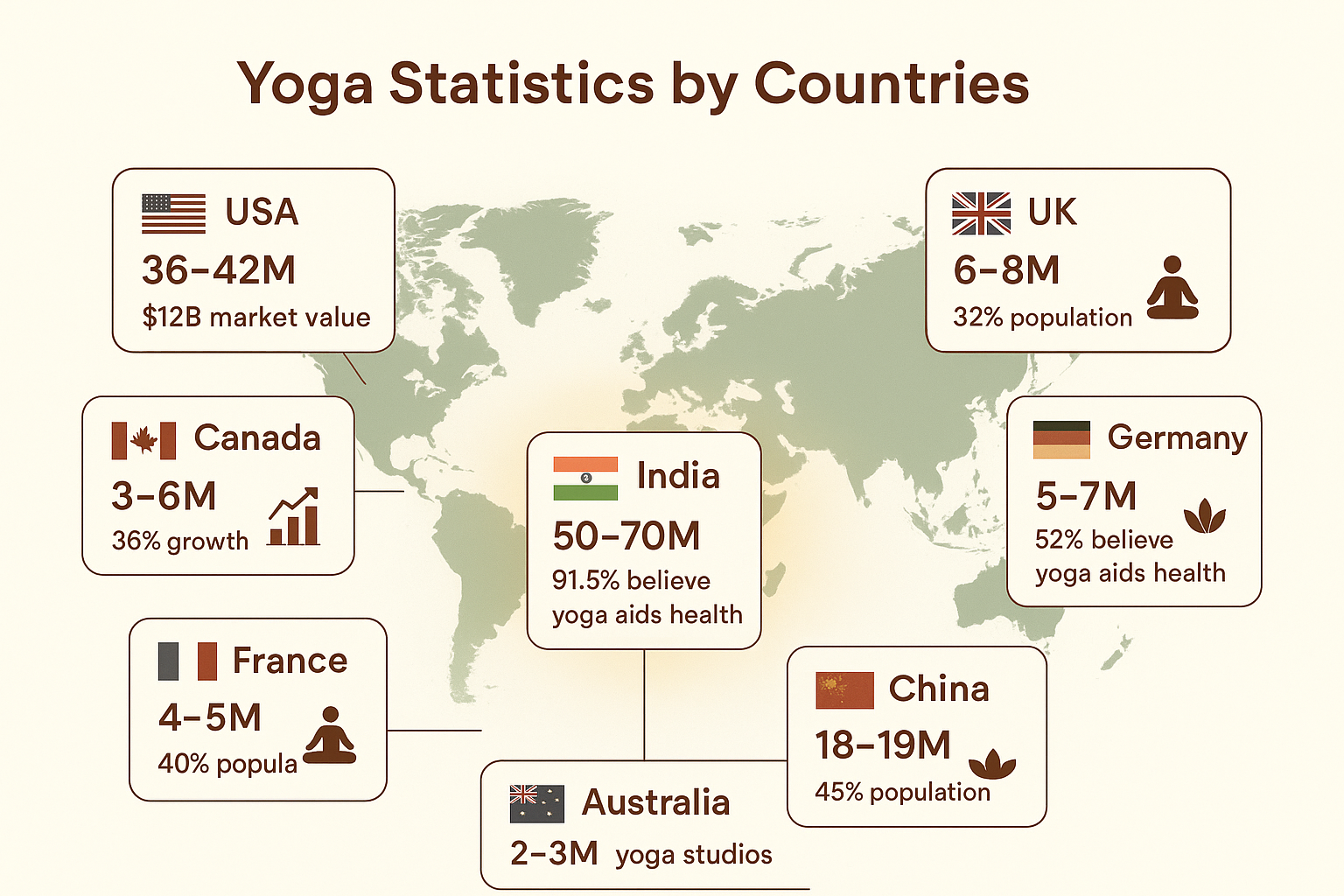
🇮🇳 India
Practitioners: 50-70 million (4-6% of population)
Market Characteristics: As yoga’s birthplace, India maintains unique cultural significance. Over 91.5% of Indians believe yoga can help prevent and treat health conditions.
Popular Styles: Traditional forms including Ashtanga, Iyengar, and Sivananda coexist with modern fitness-oriented approaches
Trends: India has seen a 30% increase in wellness tourism in the last 5 years. The government actively promotes yoga through International Yoga Day and various initiatives.
Notable: India & Nepal attract most international yoga tourists due to low-cost teacher training, spiritual heritage, and well-established retreat hubs like Rishikesh and Goa
🇺🇸 United States
Practitioners: 36-42 million (10-11% of population)
Market Value: $12+ billion yoga studio market
Popular Styles: Hot yoga, originally known as Bikram yoga, is the most practiced style, with Hatha at second place. Vinyasa, Power Yoga, and Yin also extremely popular.
Innovation Hub: Leading in digital platforms, teacher training programs, and yoga research.
Corporate Integration: More than 70% of Fortune 500 companies are incorporating employee wellness programs featuring yoga and mindfulness
🇬🇧 United Kingdom
Practitioners: 4-5 million (6-7% of population)
Market Value: The studio market is worth £895m
Popular Styles: Vinyasa, Hatha, and Ashtanga dominate, with growing interest in therapeutic and restorative practices
Trends: Strong integration with NHS and healthcare system; growing emphasis on yoga therapy for mental health
🇩🇪 Germany
Practitioners: 3-4 million (4-5% of population)
Market Characteristics: Health insurance companies often cover yoga therapy, driving medical integration
Popular Styles: Emphasis on precise alignment and therapeutic approaches; strong Iyengar community
Trends: Corporate wellness adoption; yoga prescribed for back pain and stress management
🇨🇦 Canada
Practitioners: 3-4 million (8-10% of population)
Market Characteristics: Similar to US market with high per-capita participation
Popular Styles: Diverse offerings from traditional to athletic styles
Trends: Growing francophone yoga community; strong outdoor yoga culture
🇦🇺 Australia
Practitioners: 2-3 million (8-11% of population)
Market Value: The studio industry is worth $635m
Popular Styles: Beach yoga, outdoor practices, and fusion styles combining surfing/yoga
Trends: Very high per-capita participation rates; premium market with strong spending
🇫🇷 France
Practitioners: 2-3 million (3-4% of population)
Market Characteristics: Growing European market with emphasis on mind-body connection
Popular Styles: Traditional Hatha, Vinyasa, and increasing interest in Yin yoga
Trends: Spain, Portugal, and Greece are leading destinations for luxury yoga retreats with higher per-trip spend
🇯🇵 Japan
Practitioners: 2-3 million (2-3% of population)
Market Growth: 413% increase in the number of yoga practitioners in the last five years
Popular Styles: Blend of traditional Indian yoga with Japanese aesthetics; hot yoga very popular
Trends: Strong corporate wellness integration; technological innovation in yoga apps
🇨🇳 China
Practitioners: 30-40 million (2-3% of population)
Market Value: Yoga-related revenue in China was expected to almost double from 25.4 billion yuan ($3.6bn) to 46.8 billion yuan ($6.6bn) over a five year period
Popular Styles: Fitness-oriented approaches; hot yoga; aerial yoga gaining traction
Trends: Rapid urban expansion; growing middle class investing in wellness; strong online platform growth
Yoga Trends in 2025-2026
Rise of Hybrid Yoga Models
Yoga has gone hybrid — mixing in-person and online classes. Around 40% of practitioners prefer virtual sessions, and studios offering both earn 30–40% more per client. This model offers flexibility, access to global teachers, and consistent practice anywhere.
Popular Yoga Styles
Trending: Vinyasa and Flow remain favorites, while Restorative/Yin, Therapeutic, and Aerial Yoga are growing fast.
Classics: Hatha, Ashtanga, and Iyengar continue to attract loyal practitioners worldwide.
Digital Yoga & Social Media
Social media drives yoga’s global reach. Influencers on Instagram, YouTube, and TikTok make yoga accessible and trendy — with #yoga gaining billions of views. Online classes and communities keep people connected and inspired.
Corporate Yoga
About 44% of companies now include yoga in wellness programs to reduce stress, improve focus, and boost morale. Even 70% of Fortune 500 firms offer yoga or mindfulness sessions — a growing market for yoga teachers.
AI & Tech in Yoga
AI and wearables are revolutionizing practice. Smart mats, VR/AR tools, and AI-powered apps offer real-time feedback and personalized sessions, making yoga more engaging for the digital generation.
Health Benefits Of Yoga Backed By Science
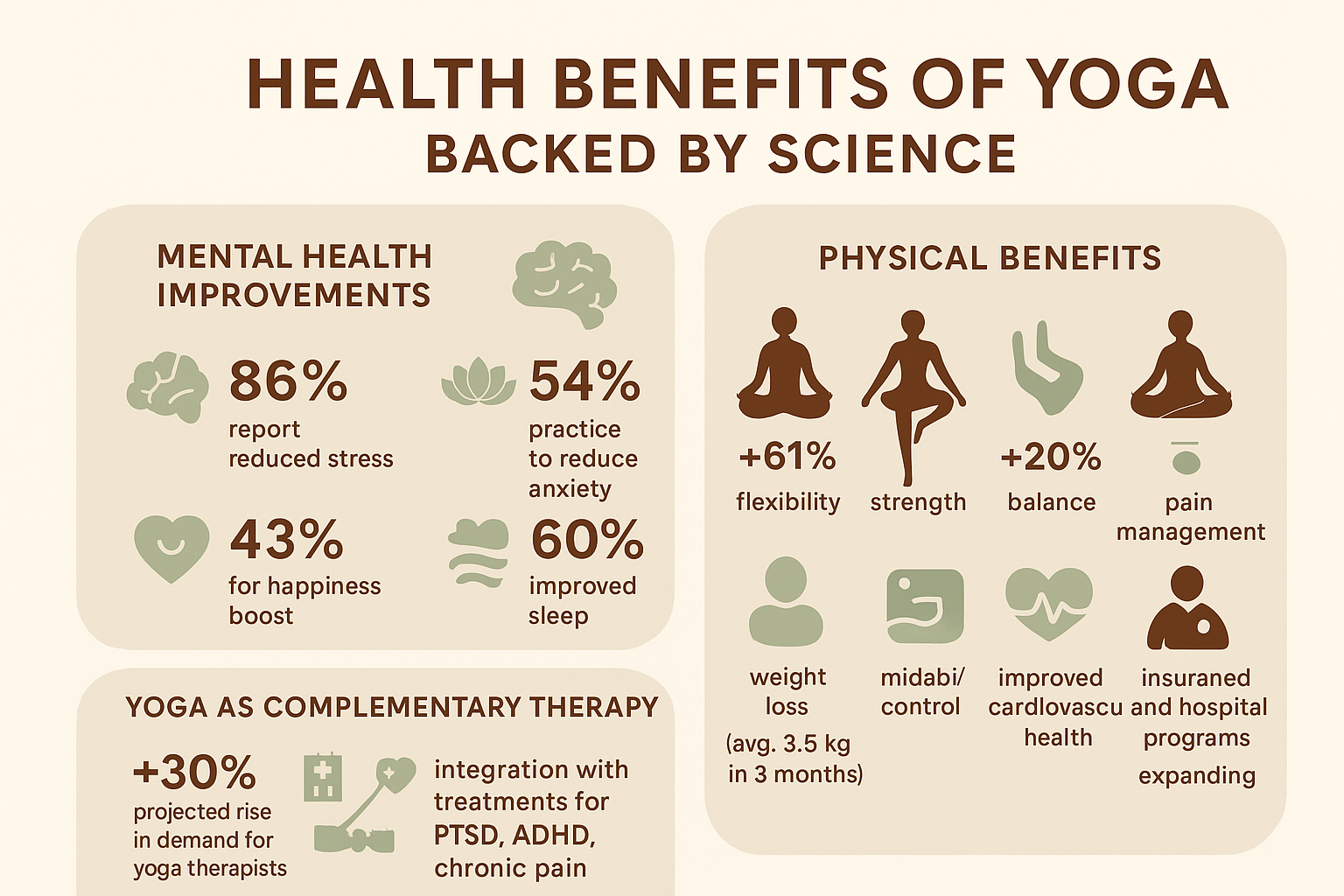
Mental Health Improvements
Reports revealed that over 86% of the population of yoga practitioners noticed a significant amount of reduction in their stress levels. Additional mental health benefits supported by research include:
- Stress Reduction: A review of 12 scientific studies involving 672 participants found that yoga reduced feelings of stress
- Anxiety Relief: 54% of yoga enthusiasts practice daily in order to reduce their stress and anxiety
- Depression Management: Yoga is being recognized as a potential alternative for the treatment of mood disorders, with multiple studies supporting its therapeutic benefits
- Emotional Wellbeing: 43% practice yoga for a happiness boost
- Sleep Improvement: Nearly 60% of yogis feel that practicing yoga improves their sleep
Physical Benefits
Yoga provides numerous measurable physical health improvements:
- Flexibility and Strength: 61% of practitioners seek better flexibility. Regular practice improves range of motion, builds muscle mass, and maintains strength.
- Pain Management: Among adults who practiced yoga, a significant percentage practiced yoga to treat or manage pain, particularly for back pain, arthritis, and chronic conditions.
- Weight Management: In three months, yoga practitioners can shed an average of 3.5 kg (7.7 lbs) based on moderate-level yoga classes three times a week.
- Cardiovascular Health: Regular practice improves circulation, lowers blood pressure, and supports heart health.
- Balance and Coordination: Practitioners are 20% more likely to report having good balance, good dexterity, and good range of motion.
Yoga as Complementary Therapy
Healthcare systems increasingly recognize yoga’s therapeutic value:
- A projected 30% rise in demand for yoga therapists in healthcare settings, rehabilitation centers, and mental health clinics
- Prescribed for conditions including ADHD, PTSD, chronic pain, and digestive issues
- Integration with conventional medical treatments
- Insurance coverage expanding in some countries
- Hospital-based yoga programs growing
Yoga Teacher Training and Retreat Industry
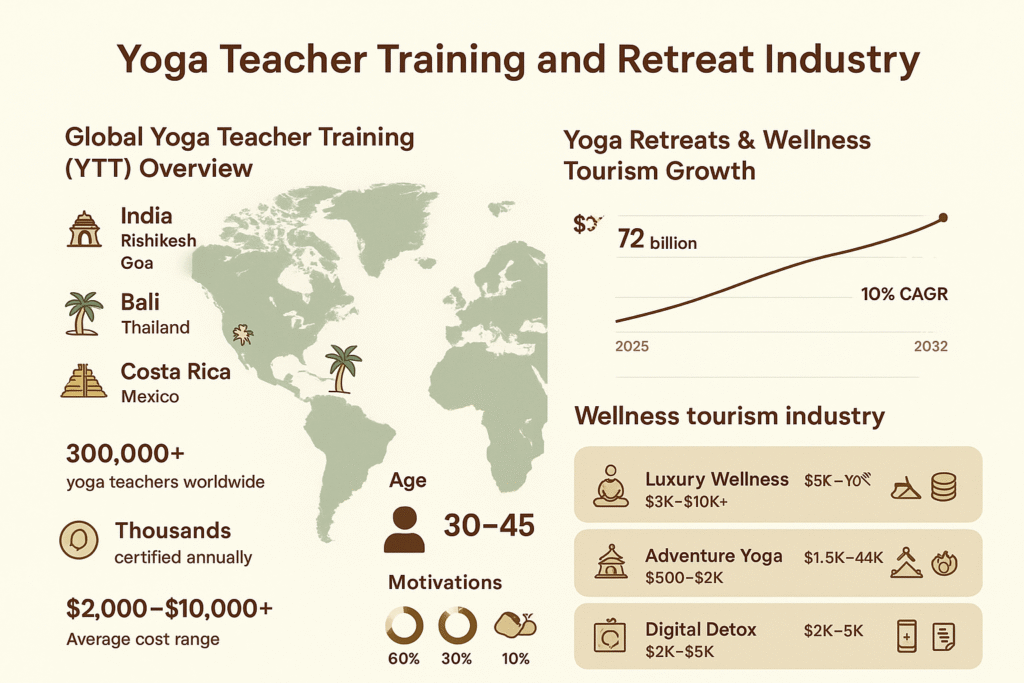
Global Teacher Training Programs
There are an estimated 300,000 yoga teachers worldwide, with thousands more completing certification programs annually. The 200-hour Yoga Teacher Training (YTT) has become a standard credential, though 300-hour and 500-hour advanced certifications are increasingly common.
Top Destinations for YTT:
- India (Rishikesh, Goa, Kerala) – Traditional training at source; affordable pricing; spiritual atmosphere
- Bali, Indonesia – Tropical setting; international community; affordable luxury
- Thailand (Koh Samui, Chiang Mai) – Beautiful locations; reasonable costs; retreat atmosphere
- Costa Rica – Natural beauty; eco-focused; accessible for North Americans
- Mexico (Tulum, Baja) – Proximity to US market; beach settings; emerging hub
Average Costs: YTT programs range from $2,000-$10,000+ depending on location, accommodation quality, and program prestige.
Participant Demographics: The typical YTT student is 30-45 years old, has been practicing yoga for 3-5 years, and is motivated by personal development (60%), career change aspirations (30%), or desire to deepen their practice (10%).
Growth of Yoga Retreats and Wellness Tourism
The yoga retreat industry has experienced explosive growth, becoming a cornerstone of the global wellness tourism sector. The global yoga tourism market is valued at USD 72 billion in 2025 with a projected CAGR of 10% through 2032.
Market Dynamics:
- The global wellness tourism industry is set to grow to $1.3 trillion by 2030, with yoga retreats being a major contributor
- India has seen a 30% increase in wellness tourism in the last 5 years
- Spain, Portugal, and Greece are leading destinations for luxury yoga retreats with higher per-trip spend
- India & Nepal attract most international yoga tourists due to low-cost teacher training, spiritual heritage, and well-established retreat hubs
Popular Retreat Types:
- Luxury Wellness Retreats: High-end accommodations with spa services, gourmet meals, and personalized instruction ($3,000-$10,000+ per week)
- Adventure Yoga Retreats: Combining yoga with surfing, hiking, or other activities ($1,500-$4,000 per week)
- Traditional Ashram Stays: Authentic spiritual experiences with simple accommodations and vegetarian meals ($500-$2,000 per week)
- Digital Detox Retreats: Tech-free environments focusing on mindfulness and reconnection ($2,000-$5,000 per week)
- Yoga Teacher Training Retreats: Immersive certification programs in exotic locations ($2,500-$8,000 for 200-hour programs)
Yoga Injuries Statistics
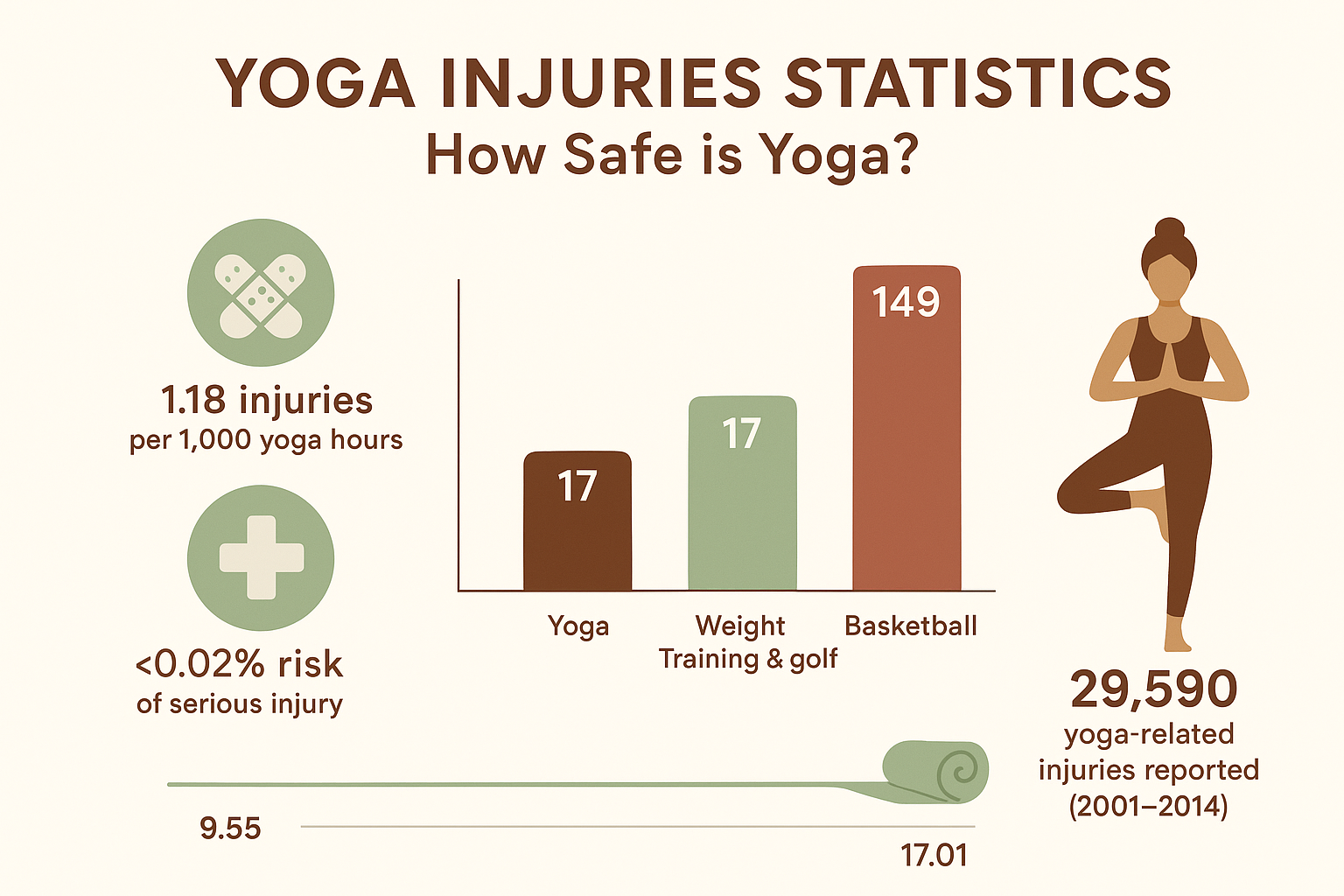
The incidence of injury among yoga practitioners is 1.18 injuries per 1000 yoga hours. The rate of yoga-related injuries increased from 9.55 per 100,000 participants in 2001 to 17.01 per 100,000 participants in 2014, though the risk of a serious injury remains quite low – less than 0.02%. Between 2001 and 2014, there were 29,590 yoga-related injuries seen in hospital emergency departments.
Yoga’s injury rate is comparable to weight-training and golf, while significantly lower than high-impact sports like basketball (149 injuries per 100,000 participants).
Digital Yoga & Technology
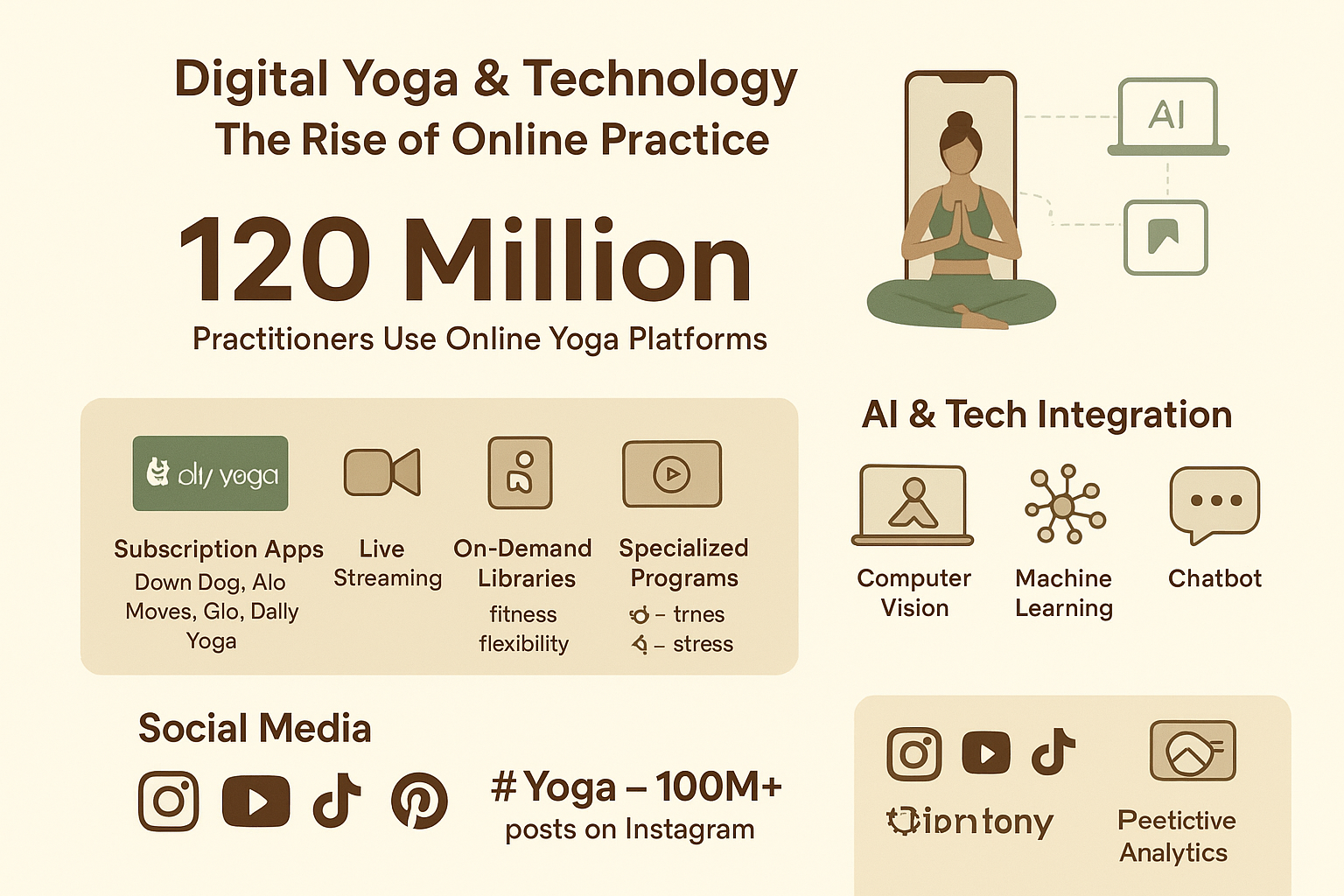
Online Yoga App Usage Growth
The digital yoga revolution shows no signs of slowing. More than 120 million yoga practitioners rely on virtual classes in 2025. Leading platforms include:
- Subscription Apps: Down Dog, Alo Moves, Glo, and Daily Yoga offer extensive libraries and personalized recommendations
- Live Streaming: Platforms enable real-time interaction with instructors
- On-Demand Libraries: Thousands of classes available anytime
- Specialized Programs: Apps targeting specific goals like weight loss, flexibility, or stress reduction
Virtual and AI-Assisted Yoga Training
Artificial intelligence is transforming online yoga instruction:
- Computer vision technology analyzes practitioner form through device cameras
- Machine learning algorithms create personalized practice sequences
- Chatbots provide 24/7 answers to yoga questions
- Predictive analytics suggest optimal practice times and styles
Social Media Impact
Platform-Specific Trends:
- Instagram: Visual platform perfect for pose demonstrations and inspirational content (#yoga has 100M+ posts)
- YouTube: Long-form classes and tutorials; many successful creators offer entire practices free
- TikTok: Quick tips, challenges, and entertaining yoga content reaching younger audiences
- Pinterest: Sequencing ideas, quotes, and visual inspiration
Social media has democratized yoga knowledge while simultaneously creating new marketing opportunities and challenges related to authentic representation versus commercialization.
Interesting Yoga Facts
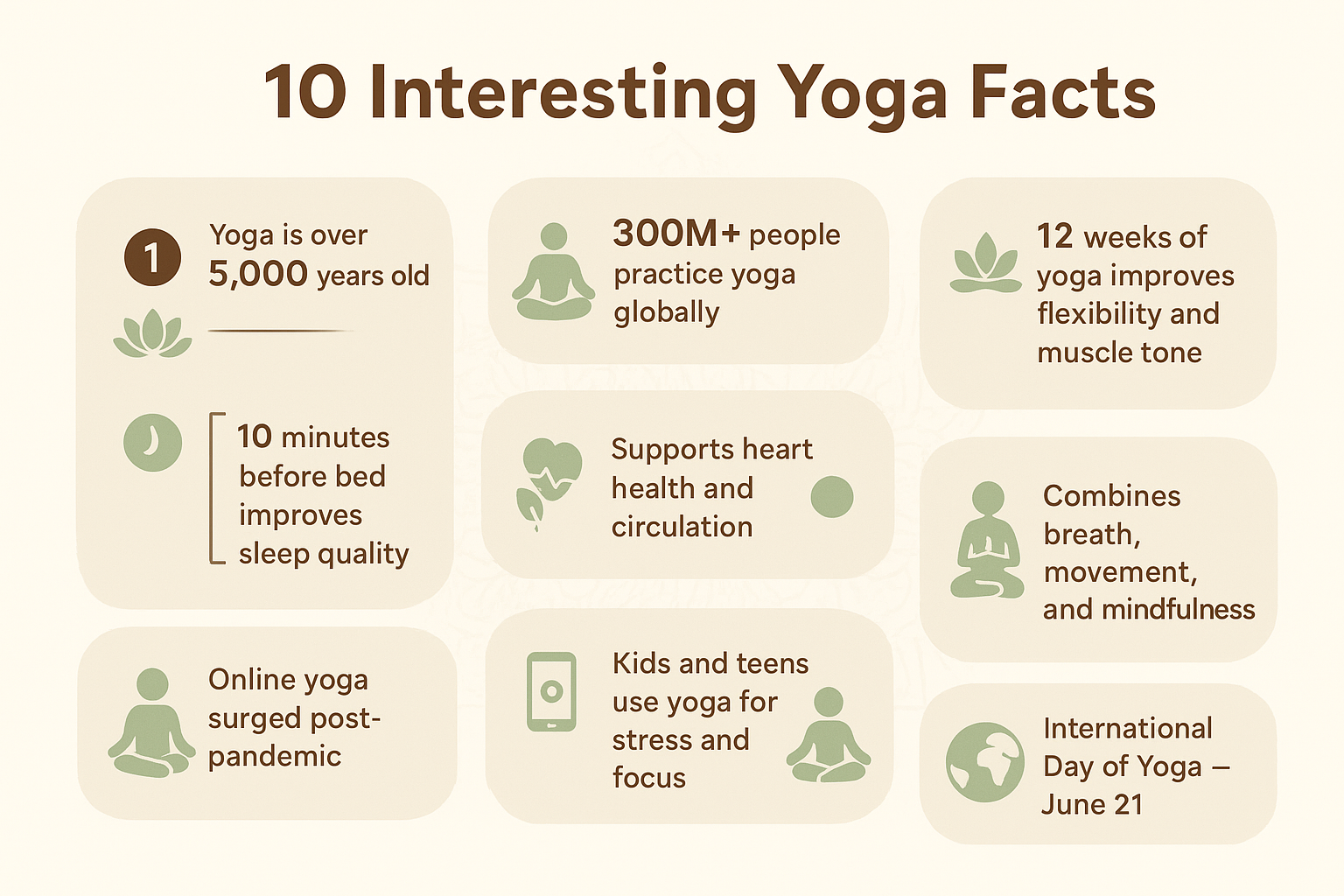
- Yoga is over 5,000 years old, making it one of the world’s oldest wellness practices.
- More than 300 million people practice yoga worldwide — and the number keeps growing every year.
- Just 12 weeks of regular yoga can significantly improve flexibility, balance, and muscle tone.
- Yoga reduces stress hormones like cortisol and boosts mood by increasing serotonin levels.
- Even 10 minutes of gentle yoga before bed can improve sleep quality and reduce insomnia.
- Yoga supports heart health — regular practice can lower blood pressure and improve circulation.
- Online yoga classes have surged since the pandemic, with millions now practicing via apps and YouTube.
- Kids and teens are taking up yoga more than ever, helping them manage stress and improve focus at school.
- Yoga isn’t just physical — it combines breath, movement, and mindfulness for complete mind-body wellness.
- The International Day of Yoga is celebrated every year on June 21, recognized by the United Nations.
Sources
https://www.grandviewresearch.com/industry-analysis/yoga-market-report
https://www.yogajournal.com/lifestyle/yoga-in-the-world-2022/
https://www.cdc.gov/nchs/products/databriefs/db324.htm
https://www.health.harvard.edu/blog/new-survey-reveals-the-rapid-rise-of-yoga-and-why-some-people-still-havent-tried-it-201603079179
https://www.statista.com/statistics/191625/participants-in-yoga-in-the-us-since-2008/
https://trends.google.com/trends/explore?date=all&q=yoga
https://www.sciencedirect.com/science/article/pii/S2059775421002972
https://theconversation.com/the-yoga-paradox-how-yoga-can-cause-pain-and-treat-it-80138
https://www.sciencedirect.com/science/article/abs/pii/S1360859217301225


